Eliel Saarinen
Gottlieb Eliel Saarinen (/ˈsɑːrɪnən/, Finnish: ; August 20, 1873 – July 1, 1950) was a Finnish-American architect known for his work with art nouveau buildings in the early years of the 20th century.
This article includes a list of general references, but it lacks sufficient corresponding inline citations. (May 2013) |
He was also the father of famed architect Eero Saarinen.
Eliel Saarinen | |
|---|---|
 Eliel Saarinen in early 1900s | |
| Born | Gottlieb Eliel Saarinen August 20, 1873 |
| Died | July 1, 1950 (aged 76) |
| Nationality | Finnish |
| Occupation | Architect |
| Spouse | Loja Saarinen |
| Children | |
| Awards | AIA Gold Medal |
| Buildings | |
| Projects |
|
| Design |
|
Life and work in Finland

Saarinen was educated in Helsinki at the Helsinki University of Technology. From 1896 to 1905 he worked as a partner with Herman Gesellius and Armas Lindgren at the firm Gesellius, Lindgren, Saarinen. His first major work with the firm, the Finnish pavilion at the Paris 1900 World Fair, exhibited an extraordinary convergence of stylistic influences: Finnish wooden architecture, the British Gothic Revival, and the Jugendstil. Saarinen's early manner was later christened the Finnish National Romanticism and culminated in the Helsinki Central railway station (designed 1904, constructed 1910–14).
From 1910 to 1915 he worked on the extensive city-planning project of Munksnäs-Haga and later published a book on the subject. In January 1911 he became a consultant in city planning for Tallinn, Governorate of Estonia and was invited to Budapest to advise in city development. In 1912, a brochure written by Saarinen about the planning problems of Budapest was published. He was runner up behind Walter Burley Griffin in an international competition to design the new Australian capital city of Canberra in 1912, but the following year he received the first place award in an international competition for his plan of the city of Reval, now known as Tallin. From 1917 to 1918 Saarinen worked on the city-plan for greater Helsinki. He also designed a series of postage stamps issued 1917 and the Finnish markka banknotes introduced in 1922.
After the divorce from his first wife, Mathilde (who then married Herman Gesellius), on March 6, 1904, Saarinen married his second wife, Louise (Loja) Gesellius, a sculptor in Helsinki, and the younger sister of Herman Gesellius. They had a daughter Eva-Lisa (Pipsan) on March 31, 1905, and a son Eero on August 20, 1910.
Move to the United States
Eliel Saarinen moved to the United States in 1923 after his competition entry for the Tribune Tower in Chicago, Illinois, won second place. While it was not built, the streamlined design inspired the architecture of many other skyscrapers. Saarinen first settled in Evanston, Illinois, where he worked on his scheme for the development of the Chicago lake front. In 1924 he became a visiting professor at the University of Michigan.
In 1925 George Gough Booth asked him to design the campus of Cranbrook Educational Community, intended to be an American equivalent to the Bauhaus. Saarinen taught there and became president of the Cranbrook Academy of Art in 1932. Among his student-collaborators were Ray Eames (then Ray Kaiser) and Charles Eames; Saarinen influenced their subsequent furniture design.
During 1929–34, Saarinen contributed product designs for the Wilcox Silver Plate Co. / International Silver Company in Meriden, Connecticut. His iconic tea urn (c. 1934) was first exhibited in 1934–35 at the Metropolitan Museum of Art in New York. Over the years, the tea urn has been widely exhibited, including in St. Louis Modern (2015–16) at the St Louis Art Museum, Cranbrook Goes to the Movies: Films and Their Objects, 1925–1975 at the Cranbrook Art Museum (2014–15)., and in 2005–07, in the touring exhibition Modernism in American Silver: 20th-Century Design, organized by the Dallas Museum of Art, which also traveled to the Smithsonian Institution in Washington, DC. In 1951–52, the tea urn was featured in the Eliel Saarinen Memorial Exhibition which traveled to multiple venues across the United States. In addition to Cranbrook, the Dallas Museum and the St Louis Museum, The British Museum in London and the Metropolitan Museum of Art also hold tea urn-related Eliel Saarinen designs.
Eliel Saarinen became a professor in the University of Michigan's Architecture Department.
His son, Eero (1910–1961), became one of the most important American architects of the mid-20th century, as one of the leaders of the International style. Saarinen's student Edmund N. Bacon achieved national prominence as Executive Director of the Philadelphia City Planning Commission from 1949 to 1970.
Eliel received the AIA Gold Medal in 1947.
Significant works


| Work | Location | Finished | Picture |
|---|---|---|---|
| Finnish Pavilion at the Exposition Universelle (designed with Herman Gesellius and Armas Lindgren) | Paris | 1900 | 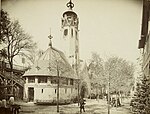 |
| Hvitträsk | Kirkkonummi | 1902 |  |
| National Museum of Finland | Helsinki | 1904 | 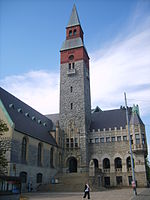 |
| Luther Factory Workers' Canteen and People's House (designed with Herman Gesellius and Armas Lindgren) | Tallinn | 1905 |  |
| Helsinki Central railway station | Helsinki | 1909 |  |
| Lahti Town Hall | Lahti | 1911 | 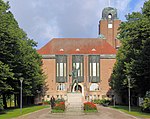 |
| Former Credit Bank Headquarters ("Saarinen House") | Tallinn | 1912 | 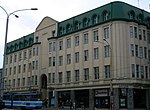 |
| Vyborg railway station | Vyborg | 1913 | 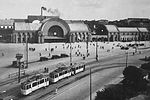 |
| Joensuu Town Hall | Joensuu | 1914 |  |
| Saint Paul's Church | Tartu | 1917 |  |
| Marble Palace | Helsinki | 1918 | 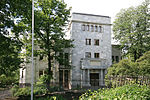 |
| Munkkiniemi Pension house | Helsinki | 1920 |  |
| Koussevitzky Music Shed | Lenox | 1938 | 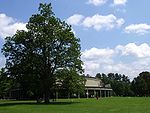 |
| Kleinhans Music Hall | Buffalo | 1940 |  |
| Crow Island School | Winnetka | 1940–41 | 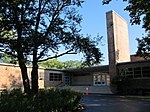 |
| First Christian Church | Columbus, IN | 1942 | 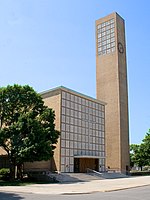 |
| Cranbrook Educational Community | Bloomfield Hills | 1940s | 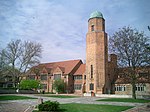 |
| Des Moines Art Center | Des Moines | 1948 |  |
| Christ Church Lutheran | Minneapolis | 1949 | 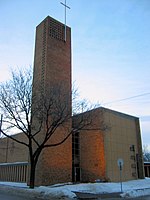 |
See also
References
Further reading
- Saarinen, Eliel (1985). The search for form in art and architecture. New York: Dover.
- Saarinen, Eliel (1943). The City: Its Growth, its decay, its future. New York: Reinhold publishing corporation.
- Hausen, Marika, ed. (1984). Eliel Saarinen: 1873–1950 – Works in Finland. Helsinki: Museum of Finnish Architecture.
- A&E with Richard Guy Wilson, Ph.D.,(2000). America's Castles: Newspaper Moguls, Pittock Mansion, Cranbrook House & Gardens, The American Swedish Institute. A&E Television Network.
- Hill, Eric J. and John Gallagher (2002). AIA Detroit: The American Institute of Architects Guide to Detroit Architecture. Wayne State University Press. ISBN 0-8143-3120-3.
- Pelkonen, Eeva-Liisa (2006). Eero Saarinen. New Haven: Yale University Press. ISBN 0-300-11282-3.
External links

This article uses material from the Wikipedia English article Eliel Saarinen, which is released under the Creative Commons Attribution-ShareAlike 3.0 license ("CC BY-SA 3.0"); additional terms may apply (view authors). Content is available under CC BY-SA 4.0 unless otherwise noted. Images, videos and audio are available under their respective licenses.
®Wikipedia is a registered trademark of the Wiki Foundation, Inc. Wiki English (DUHOCTRUNGQUOC.VN) is an independent company and has no affiliation with Wiki Foundation.